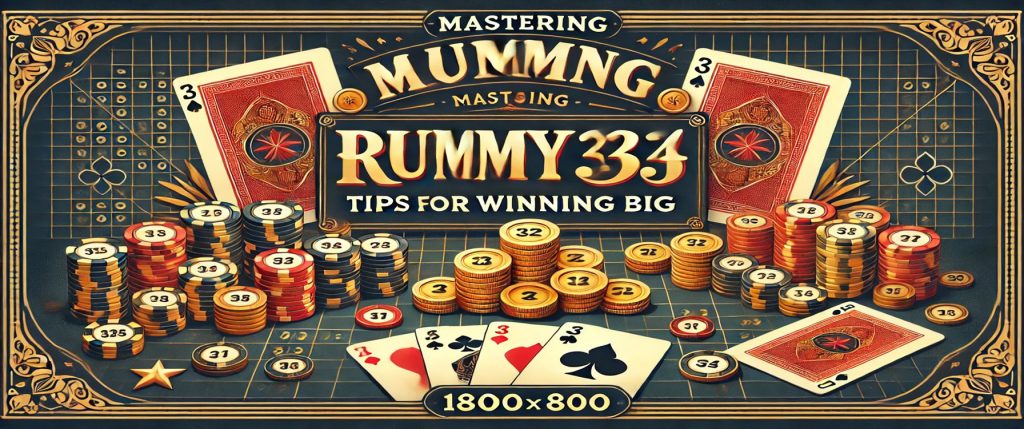Description

Getting the Hang of Rummy 334: A Complete Guide Rummy 334 is a well-liked card game that involves a little bit of luck, skill, and strategy. Two to six players usually participate, & a standard deck of cards is used for play. Making legitimate sets and sequences out of the cards in your hand while reducing the number of points remaining in your hand after another player leaves is the aim of the game. Both novice and expert players should grasp the fundamentals of Rummy 334 since they provide the groundwork for creating winning strategies and enhancing gameplay in general. Rummy 334 is fundamentally based on the ideas of discarding and blending.
Players try to form legitimate combinations, or melds, by drawing cards from the discard pile or the stockpile. Three or four cards of the same rank but different suits make up a set, and three or more consecutive cards of the same suit make up a sequence. Also, the game introduces the idea of wild cards, which can be used to complete a meld in place of any other card.
For players to successfully navigate the game & make wise decisions during their turns, they must comprehend these basic rules and mechanics. Players who want to succeed in Rummy 334 need to create a winning strategy that incorporates both offensive & defensive tactics. Assessing your hand at the beginning of the game is the first step in developing a successful strategy. As the game goes on, players should focus on creating melds as soon as possible while also keeping an eye out for possible combinations.
This entails keeping your attention on your own hand as well as watching your opponents pick up and discard cards. By doing this, you can determine their plans and modify your approach accordingly, preventing their possible melds or taking advantage of their discards. The management of risk versus reward is another essential component of creating a successful strategy. To reduce the number of points in hand, players must choose when to discard certain cards and when to hold onto them for possible future melds.
The number of cards in the stockpile and the possibility that opponents will complete their hands are two factors that must be carefully taken into account during this decision-making process. A well-rounded strategy will strike a balance between conservative play, which makes sure you don’t expose yourself to high-point cards in your hand, & aggressive play, which aims to go out quickly. In Rummy 334, wild cards are a special feature that has the power to drastically affect a game’s result. These cards are extremely useful for finishing melds because they can be used in place of any other card.
A significant advantage over rivals can be gained by players who know how to use wild cards effectively. You can strategically use a wild card in your hand, for example, to finish a set or sequence that would be challenging to accomplish with your current cards. Your gameplay can be more adaptive thanks to this flexibility, which lets you react to shifting conditions on the table.
It’s crucial to use wild cards sparingly, though. They can speed up the process of forming melds, but if you hold onto them for too long and another player leaves before you do, it can backfire. Also, think about blocking an opponent’s progress with your wild card if you see that they are gathering particular cards that might help them finish their melds. Using this defensive strategy can help you win more games while also upsetting their plan.
Ultimately, becoming proficient with wild cards necessitates having a deep awareness of both your hand and the moves of your opponents. When another player goes out in Rummy 334, knowing when to drop a hand is a crucial skill that can prevent you from scoring too many points. When you decide to end your turn without melding any cards, you are essentially admitting that you are not in a position to win that round.
This is known as dropping a hand. This is a serious decision that requires careful consideration of your current hand & your chances of improving it before the end of the round. It could be better to drop early rather than risk being stuck with high-point cards if you find yourself holding onto them with little chance of forming melds. When it comes to dropping a hand, timing is crucial. It might be a sign that you should think about dropping sooner rather than later if you observe that other players are creating melds quickly or if the discard pile is getting smaller. On the other hand, it might be worthwhile to hold onto your hand for a later turn if you are confident about your chances of going out soon & have multiple possible melds in progress.
In the end, practice & experience will help you develop an intuition for when to drop, which will enable you to play with greater knowledge. In order to make better decisions during your turn and gain important insights into your opponents’ strategies, it is imperative that you keep track of discards in Rummy 334. You can learn what melds your opponents are attempting to complete and which cards they might be holding onto by keeping an eye on the cards that are being discarded. Your own discarding decisions can be influenced by this information.
For instance, it might be prudent to refrain from discarding cards from a specific suit if you observe that an opponent has picked up multiple cards from that suit in order to avoid facilitating their progress. Also, keeping track of discards can assist you in spotting possible chances to create your own melds. Certain cards may be less valuable in the current game context if they are routinely discarded without being picked up by other players. Knowing this enables you to strategically choose which cards to hold onto & which to discard. You will improve your overall gameplay and raise your chances of winning in Rummy 334 by improving your ability to keep track of discards. Because it directly affects your ability to form melds and minimize points left in hand when another player goes out, effective hand management is essential in Rummy 334.
Regularly analyzing your hand for possible melds & taking into account which cards are less likely to support your overall strategy is one efficient method. In addition to spotting pairs or sequences, this entails spotting duplicate cards that could impede your progress. You can increase your chances of going out ahead of your opponents by simplifying your hand and concentrating on high-potential combinations. Also, as the game progresses, flexibility is necessary for effective hand management. Players must maintain tact in their strategy and be prepared to modify their plans in response to evolving conditions as new cards are drawn and discarded. For example, if you started out aiming for a particular meld but find that it is getting harder because of the actions of your opponents or the availability of cards, it might be time to change course and try different combinations.
This degree of flexibility will keep your opponents guessing about your plans while also improving your gameplay. The ability to identify possible combinations. Recognizing possible combinations in your own hand is only one aspect of this proactive approach; another is keeping an eye on what other people are discarding or picking up. taking advantage of melting opportunities.
Taking advantage of an opponent’s discarding of a card that could finish one of your sets or sequences can move you closer to going out. Also, taking advantage of melding opportunities requires timing. If you have several possible melds in progress, think about which ones, given the state of play, are most likely to be finished first.
halting the advancement of opponents. Setting these melds as your top priority will help you work more efficiently & improve your chances of going out before other players. Also, if you see that your opponent is almost finished with their hand, it might be a good idea to concentrate on countering their progress by strategically discarding or holding onto specific cards. It takes a combination of strategic thinking, observational abilities, and mental discipline to play smart in Rummy 334.
Keeping your attention on the game by avoiding distractions & paying attention to every player’s move is one useful strategy. In addition to monitoring crucial information like discards & possible melding opportunities, this attentiveness will enable you to detect subtle clues about your opponents’ tactics. Your decision-making skills & general performance will both improve if you remain mentally present during each turn.
Creating a pattern for every turn can also support the development of intelligent play practices. For example, pause before moving to evaluate your hand, think of potential melds, and look over recent opponent discards. This methodical approach will not only expedite your decision-making process but also guarantee that you don’t pass up important opportunities or make snap decisions based solely on emotion. Positioning yourself for success in Rummy 334 will require a combination of strategic thinking and concentrated gameplay.
To sum up, learning Rummy 334 entails comprehending its basic rules and creating strategies that work for both offensive and defensive play styles. Players can greatly increase their chances of winning by making good use of wild cards, knowing when to drop hands, monitoring discards, managing hands effectively, taking advantage of melding opportunities, and staying focused throughout the game. Anyone can master Rummy 334 and play this entertaining card game with friends and family with enough practice and experience.

